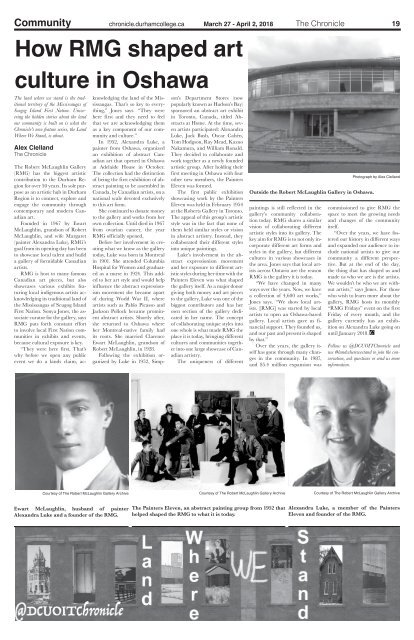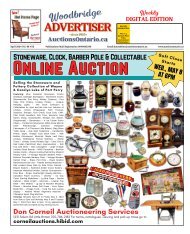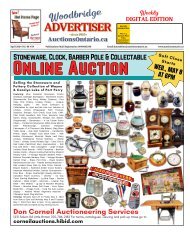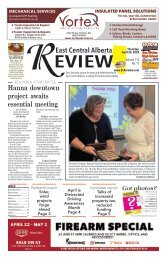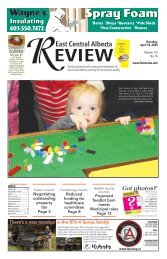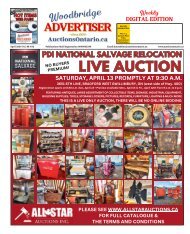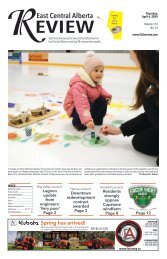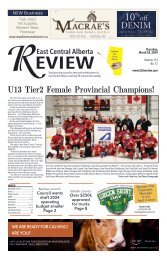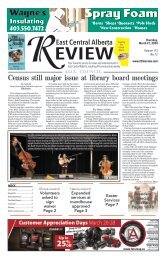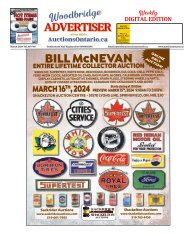You also want an ePaper? Increase the reach of your titles
YUMPU automatically turns print PDFs into web optimized ePapers that Google loves.
Community chronicle.durhamcollege.ca March 27 - April 2, 20<strong>18</strong> The <strong>Chronicle</strong> 19<br />
How RMG shaped art<br />
culture in Oshawa<br />
The land where we stand is the traditional<br />
territory of the Mississaugas of<br />
Scugog Island First Nation. Uncovering<br />
the hidden stories about the land<br />
our community is built on is what the<br />
<strong>Chronicle</strong>'s new feature series, the Land<br />
Where We Stand, is about.<br />
Alex Clelland<br />
The <strong>Chronicle</strong><br />
The Robert McLaughlin Gallery<br />
(RMG) has the biggest artistic<br />
contribution to the Durham Region<br />
for over 50 years. Its sole purpose<br />
as an artistic hub in Durham<br />
Region is to connect, explore and<br />
engage the community through<br />
contemporary and modern Canadian<br />
art.<br />
Founded in 1967 by Ewart<br />
McLaughlin, grandson of Robert<br />
McLaughlin, and wife Margaret<br />
(painter Alexandra Luke), RMG’s<br />
goal from its opening day has been<br />
to showcase local talent and build<br />
a gallery of formidable Canadian<br />
artists.<br />
RMG is host to many famous<br />
Canadian art pieces, but also<br />
showcases various exhibits featuring<br />
local indigenous artists acknowledging<br />
its traditional land of<br />
the Mississaugas of Scugog Island<br />
First Nation. Sonya Jones, the associate<br />
curator for the gallery, says<br />
RMG puts forth constant effort<br />
to involve local First Nation communities<br />
in exhibits and events,<br />
because cultural exposure is key.<br />
“They were here first. That’s<br />
why before we open any public<br />
event we do a lands claim, acknowledging<br />
the land of the Mississaugas.<br />
That’s so key to everything,”<br />
Jones says. “They were<br />
here first and they need to feel<br />
that we are acknowledging them<br />
as a key component of our community<br />
and culture.”<br />
In 1952, Alexandra Luke, a<br />
painter from Oshawa, organized<br />
an exhibition of abstract Canadian<br />
art that opened in Oshawa<br />
at Adelaide House in October.<br />
The collection had the distinction<br />
of being the first exhibition of abstract<br />
painting to be assembled in<br />
Canada, by Canadian artists, on a<br />
national scale devoted exclusively<br />
to this art form.<br />
She continued to donate money<br />
to the gallery and works from her<br />
own collection. Until died in 1967<br />
from ovarian cancer, the year<br />
RMG officially opened,<br />
Before her involvement in creating<br />
what we know as the gallery<br />
today, Luke was born in Montreal<br />
in 1901. She attended Columbia<br />
Hospital for Women and graduated<br />
as a nurse in 1924. This added<br />
to her art style and would help<br />
influence the abstract expressionism<br />
movement she became apart<br />
of during World War II, where<br />
artists such as Pablo Picasso and<br />
Jackson Pollock became prominent<br />
abstract artists. Shortly after,<br />
she returned to Oshawa where<br />
her Montreal-native family had<br />
its roots. She married Clarence<br />
Ewart McLaughlin, grandson of<br />
Robert McLaughlin, in 1928.<br />
Following the exhibition organized<br />
by Luke in 1952, Simpson’s<br />
Department Stores (now<br />
popularly known as Hudson’s Bay)<br />
sponsored an abstract art exhibit<br />
in Toronto, Canada, titled Abstracts<br />
at Home. At the time, seven<br />
artists participated: Alexandra<br />
Luke, Jack Bush, Oscar Cahén,<br />
Tom Hodgson, Ray Mead, Kazuo<br />
Nakamura, and William Ronald.<br />
They decided to collaborate and<br />
work together as a newly founded<br />
artistic group. After holding their<br />
first meeting in Oshawa with four<br />
other new members, the Painters<br />
Eleven was formed.<br />
The first public exhibition<br />
showcasing work by the Painters<br />
Eleven was held in February 1954<br />
at the Roberts Gallery in Toronto.<br />
The appeal of this group’s artistic<br />
style was in the fact that none of<br />
them held similar styles or vision<br />
in abstract artistry. Instead, they<br />
collaborated their different styles<br />
into unique paintings.<br />
Luke’s involvement in the abstract<br />
expressionism movement<br />
and her exposure to different artistic<br />
styles during her time with the<br />
Painters Eleven was what shaped<br />
the gallery itself. As a major donor<br />
giving both money and art pieces<br />
to the gallery, Luke was one of the<br />
biggest contributors and has her<br />
own section of the gallery dedicated<br />
in her name. The concept<br />
of collaborating unique styles into<br />
one whole is what made RMG the<br />
place it is today, bringing different<br />
cultures and communities together<br />
into one large showcase of Canadian<br />
artistry.<br />
The uniqueness of different<br />
Outside the Robert McLaughlin Gallery in Oshawa.<br />
paintings is still reflected in the<br />
gallery’s community collaboration<br />
today. RMG shares a similar<br />
vision of collaborating different<br />
artistic styles into its gallery. The<br />
key aim for RMG is to not only incorporate<br />
different art forms and<br />
styles in the gallery, but different<br />
cultures in various showcases in<br />
the area. Jones says that local artists<br />
across Ontario are the reason<br />
RMG is the gallery it is today.<br />
“We have changed in many<br />
ways over the years. Now, we have<br />
a collection of 4,600 art works,”<br />
Jones says. “We show local artists.<br />
[RMG] was started by local<br />
artists to open an Oshawa-based<br />
gallery. Local artists gave us financial<br />
support. They founded us,<br />
and our past and present is shaped<br />
by that.”<br />
Over the years, the gallery itself<br />
has gone through many changes<br />
in the community. In 1987,<br />
and $5.4 million expansion was<br />
Photograph by Alex Clelland<br />
commissioned to give RMG the<br />
space to meet the growing needs<br />
and changes of the community<br />
itself.<br />
“Over the years, we have fostered<br />
our history in different ways<br />
and expanded our audience to include<br />
national artists to give our<br />
community a different perspective.<br />
But at the end of the day,<br />
the thing that has shaped us and<br />
made us who we are is the artists.<br />
We wouldn’t be who we are without<br />
artists,” says Jones. For those<br />
who wish to learn more about the<br />
gallery, RMG hosts its monthly<br />
“RMG Fridays” event on the first<br />
Friday of every month, and the<br />
gallery currently has an exhibition<br />
on Alexandra Luke going on<br />
until January 20<strong>18</strong>.<br />
Follow us @DCUOIT<strong>Chronicle</strong> and<br />
use #landwherewestand to join the conversation,<br />
ask questions or send us more<br />
information.<br />
Courtesy of The Robert McLaughlin Gallery Archive<br />
Courtesy of The Robert McLaughlin Gallery Archive<br />
Courtesy of The Robert McLaughlin Gallery Archive<br />
Ewart McLaughlin, husband of painter<br />
Alexandra Luke and a founder of the RMG.<br />
The Painters Eleven, an abstract painting group from 1952 that<br />
helped shaped the RMG to what it is today.<br />
Alexandra Luke, a member of the Painters<br />
Eleven and founder of the RMG.


